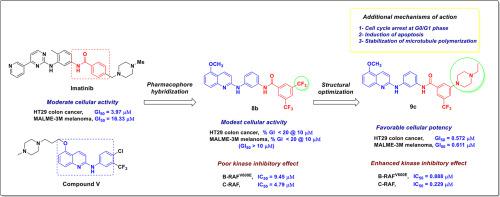European Journal of Medicinal Chemistry ( IF 6.0 ) Pub Date : 2020-08-23 , DOI: 10.1016/j.ejmech.2020.112756 Ashraf K El-Damasy 1 , Md Mamunul Haque 2 , Jung Woo Park 3 , Sang Chul Shin 4 , Jun-Seok Lee 5 , Eunice EunKyeong Kim 4 , Gyochang Keum 6

|
Prompted by the urgent demand for identification of new anticancer agents with improved potency and efficacy, a new series of arylamides incorporating the privileged 2-anilinoquinoline scaffold has been designed, synthesized, and biologically assessed. Aiming at extensive evaluation of the target compounds’ potency and spectrum, a panel of 60 clinically important cancer cell lines representing nine cancer types has been used. Compounds 9a and 9c, with piperazine substituted phenyl ring, emerged as the most active members surpassing the anticancer potencies of the FDA-approved drug imatinib. They elicited sub-micromolar or one-digit micromolar GI50 values over the majority of tested cancer cells including multidrug resistant (MDR) cells like colon HCT-15, renal TK-10 and UO-31, and ovarian NCI/ADR-RES. In vitro mechanistic study showed that compounds 9a and 9c could trigger morphological changes, apoptosis and cell cycle arrest in HCT-116 colon cancer cells. Besides, compound 9c altered microtubule polymerization pattern in a similar fashion to paclitaxel. Kinase screening of 9c disclosed its inhibitory activity over B-RAFV600E and C-RAF kinases with IC50 values of 0.888 μM and 0.229 μM, respectively. Taken together, the current report presents compounds 9a and 9c as promising broad-spectrum potent anticancer candidates, which could be considered for further development of new anticancer drugs.
中文翻译:

基于2-苯胺喹啉的芳基酰胺具有广谱抗癌作用,具有B-RAFV600E / C-RAF激酶抑制作用:设计,合成,体外基于细胞和致癌的激酶评估。
迫切需要鉴定具有增强的效力和功效的新抗癌剂,已经设计,合成和生物学评估了结合特权2-苯胺基喹啉骨架的一系列新的芳基酰胺。为了广泛评估目标化合物的效能和光谱,已使用一组代表9种癌症的60种临床上重要的癌细胞系。具有哌嗪取代的苯环的化合物9a和9c作为最活跃的成员出现,超过了FDA批准的伊马替尼药物的抗癌能力。他们引发了亚微摩尔或一位数微摩尔GI 50在大多数测试的癌细胞(包括结肠癌HCT-15,肾脏TK-10和UO-31,以及卵巢NCI / ADR-RES)中的多药耐药(MDR)细胞中,其值均保持不变。体外机理研究表明,化合物9a和9c可以触发HCT-116结肠癌细胞的形态变化,凋亡和细胞周期停滞。此外,化合物9c以与紫杉醇相似的方式改变了微管聚合模式。9c的激酶筛选显示了其对B-RAF V600E和C-RAF激酶的抑制活性,IC 50值分别为0.888μM和0.229μM。综上所述,本报告提出了化合物9a和9c是有希望的广谱有效的抗癌候选药物,可以考虑将其用于新的抗癌药物的进一步开发。











































 京公网安备 11010802027423号
京公网安备 11010802027423号